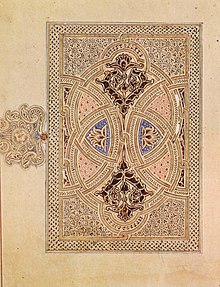Ibn al-Bawwab
Ibn al-Bawwab ( Arabic ابن البواب, DMG Ibn al-Bawwāb 'son of the porter'; Persian ابن بواب Ibn Bawwāb ; probably diedin Baghdad in 1022 ) was an important calligrapher from the Buyid period. He was also asاﺑﻦ اﻟﺴﺘﺮي / Ibn as-Sitrī known, his real name was Abu l-Hasan Ali ibn Hilal ibn Abd al-Aziz /أبو الحسن علي بن هلال بن عبد العزيز / Abū l-Ḥasan ʿAlī b. Hilāl b. ʿAbd al-ʿAzīz .
plant
Little is known about Ibn al-Bawwab's origins, he mostly lived in Baghdad. He began as a decorator of houses, later became a book illustrator and finally a calligrapher, but also devoted himself to studying the Koran, wrote works on the art of writing and hired himself as a librarian in Shiraz . Ibn al-Bawwab is said to have made 64 copies of the Koran by hand , a Koran written and illustrated around 1000 is preserved at the Chester Beatty Library .
His contribution to the development of Islamic calligraphy is considered to be of lasting importance . He took up the ideas of Ibn Muqlas and perfected the "proportioned script" ( al-ḫaṭṭ al-manṣūb ) by giving it artistic elements. Ibn al-Bawwab dealt with all calligraphic styles, but especially valued the Naschī ductus and the Muḥaqqaq . His calligraphy school continued after his death into the 13th century.
literature
- Nassar Mansour: Sacred Script: Muhaqqaq in Islamic Calligraphy . (Chapter Muḥaqqaq: The work of Ibn al-Bawwāb and Yāqūt al-Musta'ṣimī .) IB Tauris 2011. ISBN 1848854390
- DS Rice: The Unique Ibn al-Bawwab Manuscript . Dublin: Emery Walker 1955.
- J. Sourdel-Thomine: Ibn al-Bawwāb. In: Encyclopaedia of Islam , Second Edition. ISBN 9789004161214
| personal data | |
|---|---|
| SURNAME | Ibn al-Bawwab |
| ALTERNATIVE NAMES | Abu l-Hasan Ali ibn Hilal ibn Abd al-Aziz; Ibn as-Sitri |
| BRIEF DESCRIPTION | arabic calligrapher |
| DATE OF BIRTH | 10th century |
| DATE OF DEATH | uncertain: 1022 |

